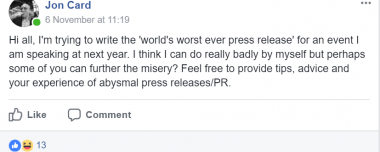Book Launch: How to Make Your Company Famous

“Every entrepreneur needs to be able to tell their company’s story. It’s an essential skill which enables you to get press, pitch for investment and win new business,” was my message for a packed room of people in Brighton.
The launch of my book, 'How to Make Your Company Famous', took place on February 20th at the Platf9rm offices in the city centre.
As well as building awareness for my book, I was also keen to help the 70+ people in attendance gain a better understanding of how the press and media works.
My main message to this audience?
Journalists are storytellers. If you want press and publicity, you need to learn how to be a storyteller. All of the world's most famous entrepreneurs - Branson, Roddick, Jobs - are all great storytellers, too.
Also speaking at the event was veteran Fleet St photographer Andrew Hasson.
How to Make Your Company Famous was designed by Meg Fenn of Worthing-based Shake It Up Creative and is available on Amazon now - you can buy it here.
How to run a crowdfunding campaign
 At the end of 2017, Full Story Media got involved in the crowdfunding campaign to raise funds for six-year-old Kyra Warrell to undergo life changing surgery. The campaign raised over £50,000 in less than two months. Here are some of the lessons learned.
At the end of 2017, Full Story Media got involved in the crowdfunding campaign to raise funds for six-year-old Kyra Warrell to undergo life changing surgery. The campaign raised over £50,000 in less than two months. Here are some of the lessons learned.
Rima and Neil Warrell needed to raise £58,000 in 58 days for their daughter to have life changing surgery. Kyra had been born with a rare condition which the NHS couldn’t treat.
But Rima had refused to give up. She scoured the internet and found a surgeon in the US, who could help. However, in order to make the surgery affordable, the operation had to be performed in Israel in February 2018.
The family raided all piggy banks and launched a campaign on Chuffed.org. When we met them they had just over £8,000. The clock was ticking…
Choose a dedicated campaigner
Someone has to take the lead in a crowdfunding campaign, and this was Rima Warrell. She was articulate and knowledgeable; able to confidently talk to the press, potential donors and backers. But, most importantly, she was available and responsive. Campaigning is a test of resolve and dedication – there are no breaks, you simply have to keep going.

Get your ducks in a row
Crowdfunding is a sales and marketing exercise. Slick campaigns are months in the making. Slogans are written, plans are drawn and investors are courted long before the campaign is published online. None of that was true for @StepWithKyra. However, the Warrells rallied friends, family, the local community, media and their MP to the cause and played a serious game of catch-up.
Create a compelling narrative
This was where Full Story came in. We created a press release: Brighton Mum vows to fight to save her daughter’s leg. This was sent across the media and gained traction in the local and national media and, most crucially, the Israeli press.
A good press release is a story – a human story. We told of the family’s struggle and the hopes of a little girl. There were a lot of quotes from Rima, explaining their plight. Also, it was filled with key facts - every fact is a potential angle for a journalist to take.
Great imagery
You can’t run a media campaign without pictures. Thankfully, we had a very cute, six-year-old girl, and a photogenic Mum. “Get a photoshoot”, we advised. A photographer friend with a good camera was found and soon the faces of Kyra and Mum Rima were all over the place. Kyra was spread across the front page of the Brighton Argus.
The viral effect
A good story travels. The local media took the story first, but then it took off in the Jewish and Israeli media. Kyra Warrell was featured in the Jerusalem Post. Soon, donations came flooding in from the global Jewish community.
Keep the story going
Once a story is out there, it takes on a life of its own. Those following it and those involved will require constant updates on developments. Social media is very useful in this respect. Ensure your chosen channels are filled with key information and kept up to date. You’ll gain supporters from unexpected quarters. When someone supports you, make sure they feel the love.
Kyra’s campaign raised over £50,000 and she was able to have her surgery. She will require more operations in the future. You can support Kyra now
How to get press for your tech startup
Creating the solution was the easy part, but now try explaining it
Technology entrepreneurs are often tremendously talented, clever and capable individuals. Some of the business plans I’ve witnessed recently are off the chart in terms of both ambition and potential impact – lab grown meats, nano-tech satellites, pollution-busting energy, not to mention the super smart AI software, which becomes more apparent by the day.
But while the leaders of these companies excel in the labs and development suites, they often face a tougher time when they head out into the real world.
Many tech entrepreneurs find it hard to explain to the man on the street what they do and, crucially, why they should really care. Talking to your peers and fellow scientists is one thing - Joe Public is quite another.
The media, who relay this information to Joe, is another challenge. Most journalists, myself included, studied arts and humanities at university, rather than science. Appreciating the importance and significance of start-ups is a challenge, and we are going to have to up our game.
But technology entrepreneurs that want coverage in the media must also learn how to communicate effectively. Every entrepreneur needs a story which can be understood by everyone. The jargon of the lab or peer group needs to be ditched and replaced by plain English. For many, this is a big challenge.
Here are five ways you can overcome the challenges and make your tech startup famous:
1) Tell us your story
Journalists want to know who you are and how you came to be working in your business. So - what’s your story? How did you come to develop your technology? Was there some kind of Eureka moment? The human story is very important.
2) Focus on the benefits
Rather than trying to describe every intricate detail, start off by explaining the end result. What problem does your technology actually solve? Does it make something cheaper, safer or more convenient? Give people a reason to want it and the details can come later.
3) Think about visuals
Every story needs a picture. If you can hold your kit in your hands and be photographed with it, that’s great. But if not, think about its impact and how that might be illustrated. A professional photoshoot is a must for media-facing businesses. Also, a good YouTube video can be very effective.
4) Emphasize your credentials
With so many big ideas floating around, it’s a challenge for journalists to gauge how credible an entrepreneur is - so we investigate their background. But entrepreneurs can help by creating a bio containing useful information such as university background, professional experience, investor backing and status of your intellectual property. That, along with an up to date LinkedIn or other online profile, will make a good first impression.
5) Be prepared to substantiate what you say
In a world of mind-blowing technology, journalists need verification of the big claims entrepreneurs make. Entrepreneurs need to get their facts and figures straight before communicating in public and then be able to back up what they say. Backing from an authoritative source such as an academic institution, research group or government body can be effective. If possible, it makes sense for journalists to be able to experience it for themselves, so offer free trials.
Jon Card has worked as a journalist for 15 years and writes regularly for The Guardian, Daily Telegraph and The Times about entrepreneurs and technology. He regularly runs training sessions on how startups can gain more press.
Writing 'the world's worst ever press release'
I am attempting to write the world's worst ever press release.
It's for an event I'm currently working on where I'll be teaching business owners how to communicate effectively with the media.

I thought an example demonstrating all of the things not to do would be an amusing way to get started.
So then I thought that a little crowdsourcing might help me. After all, if I'm going to create a true monstrosity - the sort of thing that will leave my fellow journalists writhing in agony, literally convulsing at their desks - some input from my colleagues seemed like a sensible idea.
I belong to a Facebook group where journalists offer help and advice to one another, and also complain about all the people who've upset them recently - may their ears burn.
I posted the following:

Within 48 hours, my post had gained over 200 responses. Fueled by a mixture of fury and glee, journalists offered a seemingly endless number of ways to really screw up a press release.
The group is closed, so I won't be publishing the posts directly. Also, the bilious hatred expressed by some members of the group towards certain practices of the PR industry could, all too easily, be taken out of context.
However, here are five of the best ways to really antagonise a journalist, in case you ever need to.
Incorrect names
Journalists take a dim view of emails where their names are spelt incorrectly, are addressed 'dear sir' (especially women) or messages that begin with [insert name here]. Cheery chit chat about the weather and signing off with xx also grates.
PointLess caPitalisation
The tendency for some in the PR industry to capitalise words that neither start sentences or are proper nouns draws much criticism. They don't much like exclamation marks, either.
PDFs
Press releases sent as attachments draw much ire. However, none more than the dreaded PDF which, for many journalists, has come to stand for: 'Please Do F***-off.
Burying the story
It would seem journalists like to be able to discern a tale early on, rather than several paragraphs in.
Marketing speak
Telling a journalist about your "bespoke, highly tailored, innovative solution" can lead to twitchiness.
Jon Card will be offering training sessions to businesses this year to help them get press, see upcoming events here.
Five things to consider before sending a press release
Journalists both hate and rely upon press releases, but they delete more than they ever use. Here are five questions communications teams should ask before hitting the send button.
Why are you writing this?
I often wonder why people send press releases. Were they written to please a client? Did their boss tell them to do it without explaining why? If this is the case, you’re wasting your time. The only good reason to write a press release is because you want a journalist to write a story. Fix your attentions on the job the journalist is doing.
Is there a story there?
In one sentence, say what the story is and ask yourself this question: will anyone care? Would you tell your partner about it? Or your friends in the pub? If not, then why would a journalist care or, more to the point, their readers?
Can it be read very quickly?
Journalists received countless emails every day, mainly from people working in the PR and communications industry. You should assume that whatever you send them will be read very quickly. Therefore, a press release needs to make impact right from the top; the headline and first few paragraphs are of crucial importance.
Does the headline make sense?
You don't need a Sun-style pun headline, just a short, sharp sentence that describes what the story is about. You need to be sure that the majority of people actually understand all of the words in that headline. It is common for journalists to receive press releases filled with industry jargon and acronyms – journalists might not understand these and, if they don’t, their audiences won’t, either. A good headline encapsulates what the story is actually about and contains some excitement and interest.
Are the quotes human?
Salesy quotes are a press release killer and lead to many deletions. Convince your chief executive to say something interesting. Give a point of view. Make an observation. But don’t try to sell your product, or it won’t get published.
Jon Card is a freelance business journalist who writes regularly for The Guardian, The Times and Telegraph. He will be appearing at the next Coverage Class: How to Write a Press Release








